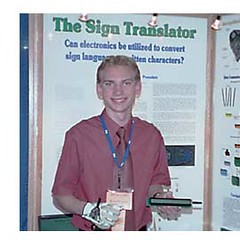
As beleaguered parents all over the country endeavor to prod their kids to finish their requisite science fair projects, some may find it helpful to provide some inspiration from past winners of the Intel International Science and Engineering Fair. These are not your basic tabletop volcanoes or series of potted sunflowers. Many sport titles that you'd expect to see gracing the pages of the most prestigious scientific journals, and some of them actually have. Others became inventions developed for use in the wider world while their inventors were still in high school. Each and every one of these projects won their teenage researchers big prizes and hefty scholarships to ensure their future success.
1. The Sign Translator
 One of the ISEF 2001 winners invented something so completely cool that he bowled over the competition to win a total of more than $200,000 in cash prizes and scholarships. The idea came to then 17-year old Ryan Randall Patterson of Grand Junction, Colorado, over an order of burger and fries at a fast food restaurant. The customers were deaf and needed an interpretor to get their order right, so Ryan decided to develop a method to make it easier for the hearing impaired to communicate with regular people.
One of the ISEF 2001 winners invented something so completely cool that he bowled over the competition to win a total of more than $200,000 in cash prizes and scholarships. The idea came to then 17-year old Ryan Randall Patterson of Grand Junction, Colorado, over an order of burger and fries at a fast food restaurant. The customers were deaf and needed an interpretor to get their order right, so Ryan decided to develop a method to make it easier for the hearing impaired to communicate with regular people. It's a glove that translates American Sign Language into large, easy to read letters on a computer screen. This is a kid who carried around an electrical cord instead of a security blanket as a toddler, and requested extension cords from Santa. He helped his dad rewire an extension to their house when he was 6, and managed to live through a bad experiment once when he stuck a screwdriver into an outlet. Ouch! Doesn't seem to have hurt his brain much, though.
2. Prototype for Autonomy: Pathway for the Blind
 Sometimes the most far-reaching discoveries come about by putting already available technologies to new uses. One big prizewinner in the 2005 ISEF fair in Phoenix did just that. 18-year old Ammem Abdulrasool, a senior at the Illinois Junior Academy of Science, developed over three years a way to allow the visually impaired to navigate themselves by using the Global Positioning System.
Sometimes the most far-reaching discoveries come about by putting already available technologies to new uses. One big prizewinner in the 2005 ISEF fair in Phoenix did just that. 18-year old Ammem Abdulrasool, a senior at the Illinois Junior Academy of Science, developed over three years a way to allow the visually impaired to navigate themselves by using the Global Positioning System. Inspired by his love for his father, who is visually impaired, Ammem set out to find a way to help and ended up not just winning the big prizes at ISEF, but being named an official Science Hero. He describes his invention, said to be one of the biggest innovations for the blind since the invention of Braille, as "an 'On-Star' system at the handheld level for the blind." Abdulrasool planned to major in business administration at the University of Illinois, Urbana Champaign.
3. Brain-Computer Interface for the Muscularly Disabled
 We older folks rely on our kids to do many computer things for us these days, so it's not surprising that the ISEF fairs have a category for computer science. In 2003's fair 16-year old Elena Leah Glassman from Central Bucks High School West in Doylestown, Pennsylvania took top awards for developing an algorithm that allows people with muscular disabilities to use computers with the help of electro-encephalographic signals.
We older folks rely on our kids to do many computer things for us these days, so it's not surprising that the ISEF fairs have a category for computer science. In 2003's fair 16-year old Elena Leah Glassman from Central Bucks High School West in Doylestown, Pennsylvania took top awards for developing an algorithm that allows people with muscular disabilities to use computers with the help of electro-encephalographic signals. The algorithm interprets signals from the brain when a person thinks about a task. For interpreting which keys on a keyboard these wavelets are signaling, Glassman achieved 90 percent accuracy using EEG wavelets she found in the public domain. When putting that to use with electrodes on her own scalp and interpreting the specific wavelets for particular keys, she managed over 70 percent accuracy. This informed her that in real life applications the software had to be customized to each user. Impressive!








No comments:
Post a Comment